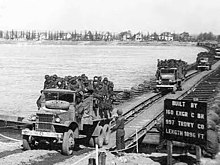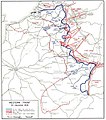Rhine crossing near Nierstein in 1945
The crossing of the Rhine near Nierstein by American troops in 1945 was a key operation on the Western Front in the final phase of World War II . Starting from Nierstein , 18 km south of Mainz , in what is now Rhineland-Palatinate , several hundred American infantrymen crossed the Rhine to southern Hesse and built bridges, over which 60,000 vehicles subsequently crossed for the further occupation of the German Empire .
procedure
prehistory

In the weeks and months of the German withdrawal , there were repeated stop orders that were militarily senseless . Often the permission to withdraw for certain units came very late (or not at all); Commanders risked penalties for giving orders to withdraw. This led to frustration among many soldiers, to leaving (or having to) equipment parts and to avoidable losses.
After the Ludendorff Bridge near Remagen was conquered undestroyed by US troops on March 7, 1945, Hitler deposed General Field Marshal Gerd von Rundstedt as Commander in Chief West and replaced it with General Field Marshal Albert Kesselring . Kesselring took over this command on March 11th.
The operation undertone was an operation of the 7th and 3rd US Army and parts of the French 1st Army from 15 to 24 March 1945 ( 6th Army Group under Jacob L. Devers ). Within this framework, the Palatinate , Rheinhessen , parts of the Rhineland and the areas of northern Alsace and Lorraine , which were temporarily lost during Operation Nordwind, came under Allied control. Allied forces broke through the last parts of the western wall still held by German troops and reached the Rhine between Koblenz and Gambsheim on a broad front .
Further north, as part of Operation Lumberjack, the 12th Army Group under General Omar Bradley advanced from their positions in the Eifel to the Rhine. They secured the left flank of the 6th US Army Group. Coming from the Düren area they cleared the area between the mouths of the Erft and Ahr and met in the Ahrweiler area with the troops of the 3rd US Army under George S. Patton.
The retreating German troops blew up the railway bridge near Mainz, a good 17 kilometers away, on March 17 (north, downstream). The Rhine bridge in Gernsheim , approx. 18 km south and upstream from Nierstein, was blown up on the evening of March 19, 1945 as part of Hitler's scorched earth order (also known as the Nero order ). On March 18, 1945, Bad Kreuznach was handed over to US troops without a fight. On March 19, 1945, US troops encountered bitter resistance from German unity in Hahnheim . We continued on today's route of federal highway 420 .
The Nierstein-Oppenheim bridgehead was cleared by German troops on the night of March 21, 1945. The combat commander, staffs and local group leaders left the area on the left bank of the Rhine. The Landskrone Rhine ferry was sunk at 1:30 p.m. in the afternoon. The population removed the anti-tank barriers to Dexheim, Schwabsburg and Nackenheim. White flags were hoisted on the watch tower, the church towers and at the town entrances, but they were fired at by German flak from the right bank of the Rhine. A delegation of German soldiers appeared to the mayor with orders to pull in the white flags and rebuild the barriers, otherwise Nierstein would be shot at by its own artillery. At 3 p.m. a German patrol was sent to Nierstein and Oppenheim. He noticed that in the meantime white flags had been hoisted again and signs were posted at the town entrances. On them was written in English that the population was peaceful; no resistance is to be expected. At 15:30 associations reached the 3rd US Army ( United States Army Central ) Dienheim , at 16 o'clock Oppenheim. At 4:15 p.m., an American motorcyclist cleared up to school in Nierstein. Shortly afterwards, the US tanks and infantry march in from Oppenheim, Dexheim and Schwabsburg. A delegation of Americans was received in the mayor's office at 5 p.m. and the first orders were announced by the bell. After 7 p.m. civilians are no longer allowed to be on the street. There is a 48-hour curfew for everyone. Firearms and daggers are to be delivered. The population should keep calm. The Rhine was thus reached at Nierstein. On March 22, 1945, US troops occupied Mainz, which was still rumored as a fortress .
Course of the operation
The operation began with moonlight and good visibility on March 22, 1945 at around 10 p.m. The first groups of George S. Patton's 3rd US Army crossed the Rhine near Nierstein. At this point, depending on the water level, it is approx. 244 to 366 meters wide. The 5th Infantry Division under Stafford LeRoy Irwin , in the XII Corps under Manton S. Eddy , carried out a surprise attack at night north of Oppenheim ; the 90th Infantry Division carried out a mock attack further downstream near Mainz behind a curtain of artificially created fog.
When the first inflatable boats landed on the right bank of the Rhine, seven German soldiers surrendered, paddled across the Rhine without an escort and taken prisoner of war in Nierstein. Two companies that landed further south came into heavy machine gun fire.
The infantry crossed in 200 rubber dinghies. On March 23, the first pontoon bridge (Treadway Bridge, "Class 40") was completed and US planes flew patrol to (re) establish air supremacy . Tanks and other heavy weapons were transferred by ferry or LCVP (landing vehicle ) .
On the afternoon of March 23rd, General Manton S. Eddy (of US XII Army Corps) ordered the 4th Armored Division under Hugh Joseph Gaffey to take off early on the morning of March 24, 1945. The US troops marched quickly, especially in the direction of Groß-Gerau.
A second treadway bridge and a heavy pontoon bridge were built one day later on March 24th. By March 31, 1945, 60,000 vehicles crossed the Rhine on these bridges.
Patton came with this action the day before the Rhine crossing of Field Marshal Bernard Montgomery at Wesel ( Operation Varsity ). It is also reported that Patton urinated into the Rhine while standing in the middle of the makeshift bridge.
On the German side, various units of the troops and, above all, young people and older men who served in the Volkssturm were under the command of General Hans-Gustav Felber . Felber was the commander of the 7th Army until March 25th . Felber's new commander, Field Marshal Albert Kesselring , and the commander of Army Group G , SS Colonel Group Leader Paul Hausser , followed the events with excitement from the command post of the XII. Corps in Gross-Gerau . Felber ordered that the officers should decide on the spot according to the situation.
aftermath
The US Army, which crossed the Rhine here, then went via Frankfurt am Main and Hanau to the Hohe Rhön in the direction of Meiningen , and from there to advance southeast to Coburg and Bayreuth by April 18, 1945 .
More crossings nearby

On March 26th at 2:30 a.m. near Worms, the 7th US Army under Alexander M. Patch crossed Ried in Hesse :
- north of Worms with 45th Infantry Division under Robert T. Frederick
- near Worms-Ibersheim to Groß-Rohrheim and Biblis with 179th US Regiment (179th Infantry Regiment) under Preston JC Murphy
- near Worms-Rheindürkheim to Nordheim with 180th US Cavalry Regiment under Everett W. Duvall
- south of Worms with 3rd Infantry Division under John W. O'Daniel
- at Bobenheim-Roxheim towards Bürstadt and Lampertheim .
On March 28th at 1 am, two translations followed near Mainz in a kind of “pincer movement”. One near the later Alexander-M.-Patch-Bridge and the other further upstream near Mainz-Laubenheim . Ginsheim-Gustavsburg were thus encircled, as the two troops reunited between Hochheim am Main and Mainz-Kastel .
On March 31st at 2:30 a.m. French troops (3rd Algerian Division) began to cross the Rhine with rubber boats near Speyer . Troops crossed a few kilometers upstream near Germersheim at dawn and were massively shot at. In order to accelerate the capture of Karlsruhe, the French general Jean de Lattre de Tassigny had a third combat group crossed between Germersheim and Karlsruhe on April 2nd.
Front lines
The following maps show the course of the front from 1944 to the unconditional surrender of the Wehrmacht in May 1945.
Western Front in late September 1944 (after Operation Market Garden )
monument
On March 25, 2017, a memorial was inaugurated on the occasion of the Rhine crossing. The memorial plaque contains information in German and English. The German text is:
“In memory of the historic bridge building
At this point, after supporting the 5th Infantry Division of the US Army near Oppenheim, the 249th Pioneer Battalion erected a 366 meters in the first successful assault to cross the Rhine since Napoleon's time on March 22 and 23, 1945 long pontoon bridge to bring parts of General George S. Patton's 3rd Army across the Rhine. The construction of the bridge only took 18 hours.
This remarkable building achievement undoubtedly helped end the war earlier and thus save the lives of countless people on both sides of the conflict. "
literature
- Heinz Leiwig : Finale 1945 Rhein-Main, with a report by contemporary witness Edmund Ritscher p. 49, Düsseldorf 1985, ISBN 3-7700-0675-5 .
- Edmund Ritscher: End of the war in Ibersheim among Americans, article on the homepage of the City of Worms / Culture / History / Stories
See also
- Eight years later, the Americans built the Anderson Barracks nearby in 1953
- Today, the Landskrone Rhine ferry operates near the pontoon landing points
- Rhine River Patrol
- The grain sand crime was committed on March 21, 1945
Web links
in German:
- www.rlb.de Rhineland-Palatinate Bibliography
- Allies cross the Rhine near Oppenheim, 22. – 23. March 1945. Contemporary history in Hessen. (As of August 20, 2012). In: Landesgeschichtliches Informationssystem Hessen (LAGIS).
- Nierstein Crossing - Silent Crossing geschichtsverein-nierstein.de
in English:
- US Army in WW II: The Last Offensive (1973), Chapter XIII: The Rhine Crossings in the South
- US Army in WW II: The Last Offensive (1973), Chapter XV At the End of March
- www.90thdivisionassoc.org (see chapter 14) (PDF; 6.3 MB)
- The Rhine River crossings ( Memento from November 9, 2013 in the Internet Archive ) (PDF; 1.2 MB)
Individual evidence
- ↑ Albert Geipert: 1933-1945 - but the Rhine flowed on, Riedstadt 2003 S. 31st
- ^ Werner Lang: End of the war in Nierstein 1945; in: Heimatbuch Landkreis Mainz ; Printed by Wilhelm Traumüller, Oppenheim am Rhein 1967; Pp. 100-101.
- ^ Werner Lang: End of the war in Nierstein 1945; in: Heimatbuch Landkreis Mainz ; Printed by Wilhelm Traumüller, Oppenheim am Rhein 1967; P. 101.
- ↑ Chapter XIII, p. 267.
- ↑ XIII, p. 270.
- ↑ Chater XIII
- ↑ Chapter XIII p. 272 below.
- ↑ History map from April 5 to 18, 1945
- ↑ Chapter XV - At the End of March at ibiblio.org









